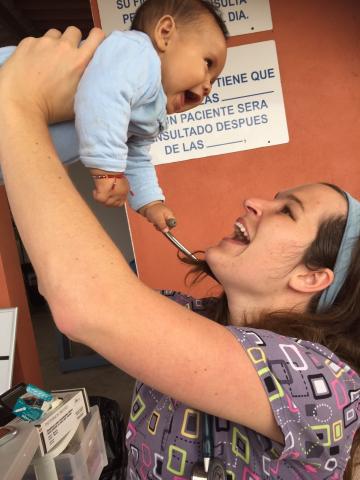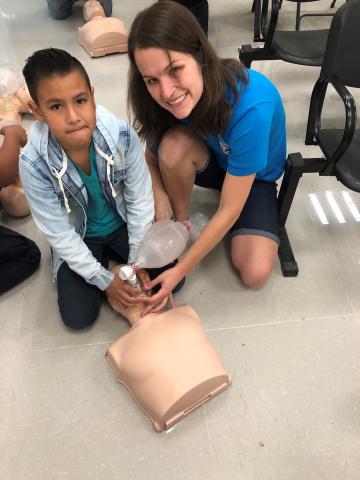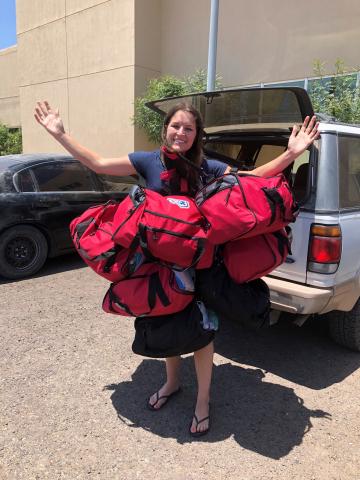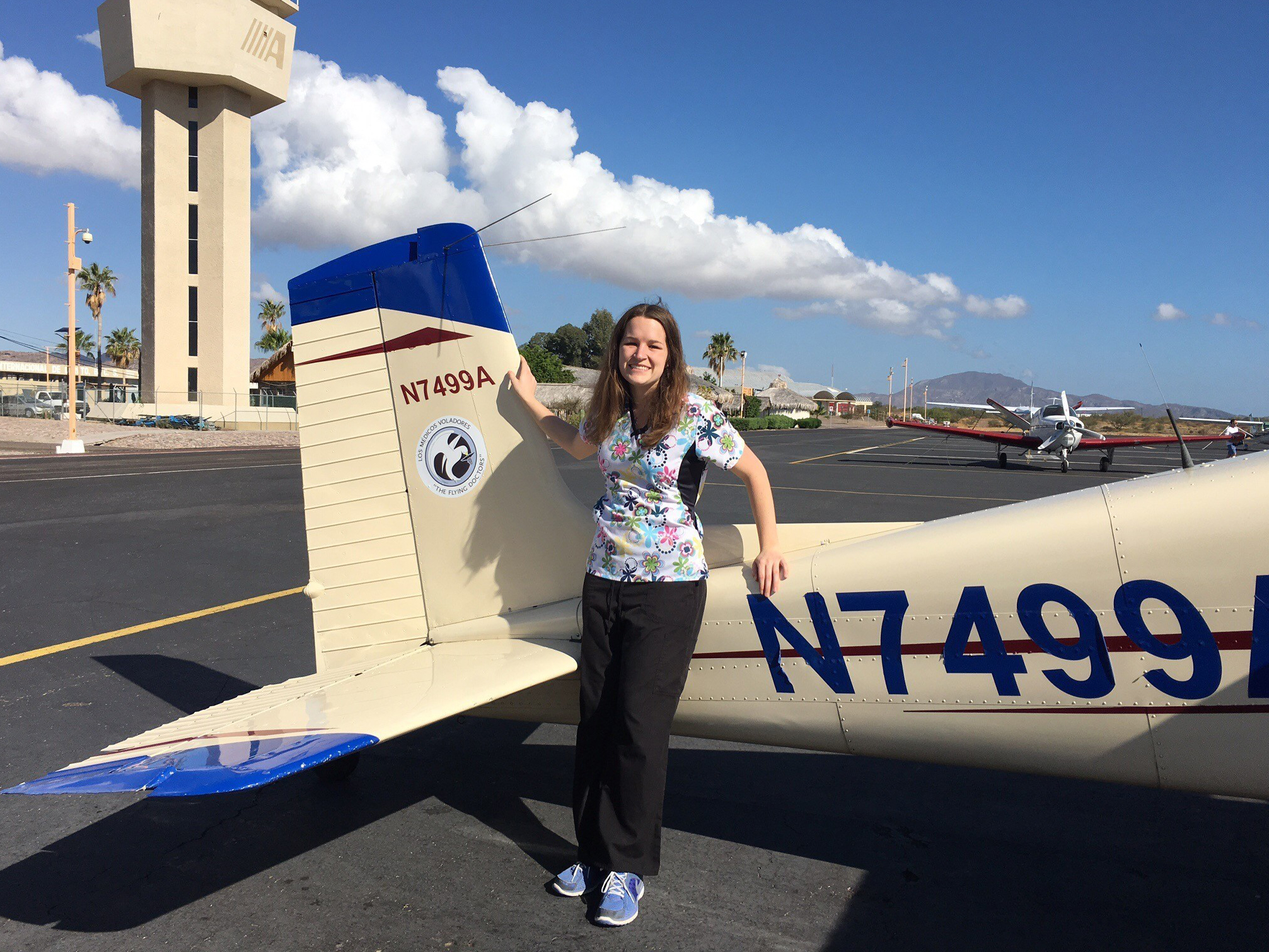Arizona Nursing BSN Alumna’s Passion for Serving the Underserved Transcends Borders
Humanitarian nursing is part of University of Arizona College of Nursing alumna Katherine Stradling’s DNA. The 2013 Bachelor of Science in Nursing (BSN) graduate founded Hands to Hearts, a nonprofit that provides education and resources to empower people to save lives. The organization offers life support courses to underserved communities in the United States, while building the first response system in rural Mexico. Hands to Hearts grew from Stradling’s experiences as a Registered Nurse with the Flying Doctors, a non-profit organization that aims to improve the health and well-being of underprivileged communities through the provision of no-cost medical, dental, and optometry clinics. “I met some of the coolest people I’ve ever met and done some of the coolest things, just working in rural clinics throughout Mexico,” Stradling says. “I absolutely love working in rural hospitals in impoverished areas, helping people that medicine sometimes misses.”

Realizing that underserved communities also suffer from a lack of Emergency Medical Training, Stradling was inspired to establish Hands to Hearts in order to offer a full roster of emergency training for in-need communities. With a mission that stresses that no one should die of treatable medical emergencies due to lack of education and resources, Hands to Hearts offers life support courses to community members both in rural Mexico and in the United States. Stradling and her team have provided training to more than 2,500 people and improve quality of life by donating unused medical supplies and equipment to medical organizations in need.
“Katherine was a third semester BSN student in her psych rotation clinicals with me as her instructor at Palo Verde Hospital,” recalls Arizona Nursing Clinical Instructor Susan Markovich, MSN, RN.
"I absolutely love working in the more rural hospitals in impoverished areas. It’s what I enjoy and I feel like it makes a huge difference. Nurses can really go above and beyond and make change for those who need it most.” ~ Katherine Stradling, BSN
“It was obvious at that time that she envisioned her nursing career as a calling in which she could devote her professional life to helping others in a Global sense.”

Tell us about the genesis of Hands to Hearts.
Once I graduated with my BSN, I moved back to California. Right at that time, the Calif. State Board of Nursing crashed, so I watched pretty much everybody in Arizona get a job while I was stuck in limbo-land for six months, unable to test. One day, I woke up and said, ‘I cannot sit here and do this anymore.’ I’ve always wanted to do humanitarian nursing, so I started researching programs and that’s when I found the Flying Doctors, which provides medical resources to rural clinics in Mexico.
That was the inspiration for Hands to Hearts, which has slowly developed over the last couple years. Now we actually offer a full three-week Emergency Medical Training program for emergency response responders and also people in rural communities.
We officially hit our two-year mark as a non-profit in October, but I’ve been doing things very similar to Hands to Heart for about three years now. Recently, I switched gears and left hospital nursing full-time, so now I live in rural Mexico for half the year.
What led to your passion for humanitarian work?
I was raised in a family that did charity work. It wasn’t something optional to volunteer, it was just what you did. I absolutely love working in the more rural hospitals in impoverished areas. It’s what I enjoy and I feel like it makes a huge difference. Nurses can really go above and beyond and make change for those who need it most.
What are some of the biggest challenges of this kind of work?
The biggest challenge we have with Hands to Hearts right now is we’re really striving for self-sufficiency. Over the last couple years, there have been a lot of articles addressing the issue of medical equality and asking if humanitarian medicine is really reaching that equality. It’s because if you come down and help these people and then leave, they’re now dependent on you. The studies are asking, ‘Is this doing long-term good?’ So what Hands to Hearts focuses on is self-sufficiency. Once students graduate our program, we train them to become instructors so that they can be self-sufficient. We currently have eight CPR instructors in rural Baja. Getting them to that point has been one of the biggest challenges, but it’s really cool when you do. This last week, I’ve had 120 people certified in CPR.

Tell us more about the programs Hands to Hearts offers.
We offer a CPR and First Aid course. We offer an education school course, which is designed for teachers and high school kids, because a lot of those rural schools are where most of the injuries are going to happen. It’s a two-day course that is designed for teachers and coaches. We also have a four-day emergency first response program, which covers how to best use your resources to get somebody to the hospital alive. Then we have the three-week pre-hospital emergency response program, which is equivalent to an emergency medical technician program.
We believe in education plus resources to empower community members. After they graduate, we give them the supplies they need to execute those courses on their own, because if you give somebody education without supplies, your education is useless. We also work with the rural hospitals, teaching classes. We’ve done a two-day trauma symposium, which was one of the first of its kind in Baja for nurses and doctors.
How many people have gone through Hands to Hearts courses?
Our classes keep getting bigger and bigger. We have certified a total of 1,500 people in CPR between the United States and Mexico. We have had a total of 13 graduates from our EMT program. And we are at 25 who have graduated our emergency first-aid certification course, which is designed for first responders.
How did your studies at UA Nursing inform your current work?
At the University of Arizona, we learned the reason ‘why’ behind things. We didn’t focus just on memorization, we focused on, for example, the path of physiology. That’s been my approach for this program and for my career in general. I’m really big on simulations, because the UA stressed simulations all the time. I adopted a lot of that structure for our program. In addition, there were always resources around helping people in the community and health equality. I became a disaster nurse because of our final semester of nursing school, because we had a rotation where they told us about the Red Cross.
What are your hopes for the future?
In May, I sold everything I own and can live out of my RAV4 because I’m working in Mexico for six months of the year. Right now, that’s what makes me happy, so I’m looking to continue that for a while. Eventually I’d like to return to school for my DNP. I think I’ll probably end up in the education route. That’s always been something that’s been calling me because I love patient care and education. I was looking back because I just hit my five-year mark of being a nurse and somebody asked me, ‘Is this where you expected to be?’ and I said, ‘No, I wanted to be a pediatric care nurse.’ I mentor a lot of new nurses and I tell them, ‘Have a plan, have a goal, but then be open for the world, because sometimes the world’s going to throw you into a situation that you’re meant to be in.’ Go in with an open mind, get the experience and learn everything you can, and the great thing about nursing is, if you don’t like something you can switch.


